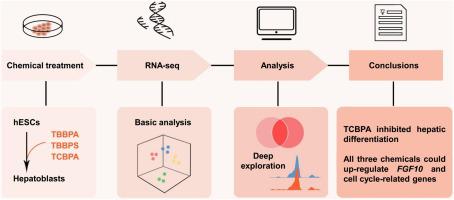Journal of Hazardous Materials ( IF 12.2 ) Pub Date : 2020-06-30 , DOI: 10.1016/j.jhazmat.2020.123341 Renjun Yang 1 , Shuyu Liu 2 , Xiaoxing Liang 1 , Nuoya Yin 1 , Linshu Jiang 3 , Yang Zhang 4 , Francesco Faiola 1

|
Halogenated flame retardants (HFRs), including Tetrabromobisphenol A (TBBPA), Tetrabromobisphenol S (TBBPS), and Tetrachlorobisphenol A (TCBPA), are widely applied in the manufacturing industry to improve fire safety and can be detected in pregnant women’s serum at nanomolar levels. Thus, it is necessary to pay attention to the three HFR potential development toxicity, which has not been conclusively addressed yet. The liver is the main organ that detoxifies our body; TBBPA exposure may lead to increased liver weight in rodents. Therefore, in this study, we assessed the developmental hepatic toxicity of the three HFRs with a human embryonic stem cell hepatic differentiation-based system and transcriptomics analyses. We mostly evaluated lineage fate alterations and demonstrated the three HFRs may have common disruptive effects on hepatic differentiation, with TCBPA being significantly more potent. More specifically, the three HFRs up-regulated genes related to cell cycle and FGF10 signaling, at late stages of the hepatic differentiation. This indicates the three chemicals promoted hepatoblast proliferation likely via up-regulating the FGF10 cascade. At the same time, we also presented a powerful way to combine in vitro differentiation and in silico transcriptomic analyses, to efficiently evaluate hazardous materials’ adverse effects on lineage fate decisions during early development.
中文翻译:

TBBPA,TBBPS和TCBPA部分地通过FGF10信号通路的上调来破坏hESC的肝分化并促进分化细胞的增殖。
卤代阻燃剂(HFR),包括四溴双酚A(TBBPA),四溴双酚S(TBBPS)和四氯双酚A(TCBPA),已广泛用于制造业,以提高消防安全性,并可在孕妇血清中检测到纳摩尔浓度的卤代阻燃剂(HFR)。因此,有必要注意三种HFR潜在的发育毒性,但尚未最终解决。肝脏是排毒我们身体的主要器官。TBBPA暴露可能导致啮齿动物肝脏重量增加。因此,在这项研究中,我们用基于人类胚胎干细胞肝分化的系统和转录组学分析评估了这三种HFR的发育肝毒性。我们主要评估了血统命运的改变,并证明了这三种HFR对肝分化可能具有共同的破坏作用,而TCBPA的效力明显更高。更具体地,在肝分化的晚期,这三个HFR上调了与细胞周期和FGF10信号传导有关的基因。这表明这三种化学物质可能通过上调FGF10级联反应来促进成肝细胞增殖。同时,我们还提出了一种强大的组合方式体外分化和计算机硅转录组分析,以有效评估有害物质对早期发育过程中血统命运决定的不利影响。











































 京公网安备 11010802027423号
京公网安备 11010802027423号